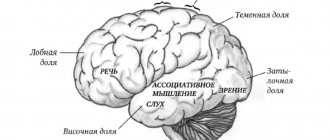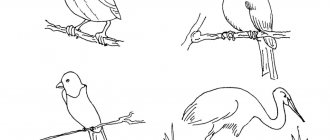Perception is a process that forms the image of objects and phenomena from the surrounding world into the structures of the psyche. This is a complete reflection of the qualities and inherent characteristics of an object and phenomenon. This is a kind of collapsed thinking. It is often interpreted not as a process, but as a result, that is, the image of the object itself. Perception is synonymous with perception, therefore the image of an object is formed with the help of the perception of primary sensations, certain knowledge, desires, expectations, imagination and mood. The main features of perception are objectivity, constancy, integrity, apperception, structure, meaningfulness, illusion, selectivity.
Perception has many synonyms: apperception, perception, evaluation, understanding, acceptance, contemplation.
Content
- Physiological mechanism of perception
- Properties of perception
- Principles of perception
- Perception factors
- Effects of perception
- Classification of types of perception
- Perceptual disturbances Illusions of perception
- Hallucinations Eidetism as a type of hallucination
If we compare the definitions of two mental processes, i.e. perceptions and sensations, then you can notice some features. For example, perception is a more complex process. If sensations reflect individual properties of objects, then perception is a holistic reflection. Thus, the result of perception is a holistic perceptual image of an object, and not a separate property of it.
Physiological mechanism of perception
The physiological basis of perception is the processes taking place in the sense organs, nerve fibers and the central nervous system. Under the influence of stimuli at the endings of the nerves present in the sensory organs, nervous excitation arises, which is transmitted along pathways to the nerve centers, and, ultimately, to the cerebral cortex. Here it enters the sensory zones of the cortex, which represent, as it were, the central projection of the nerve endings present in the sense organs. Depending on which organ the sensory zone is connected to, certain sensory information is generated.
Since perception is closely related to sensation, it can be assumed that it, like sensation, is a reflexive process. Ivan Petrovich Pavlov showed that perception is based on conditioned reflexes, i.e. temporary nerve connections formed in the cerebral cortex when receptors are exposed to objects or phenomena.
Temporary nerve connections that ensure the process of perception can be of two types: 1. Formed within the same analyzer; 2. Interanalyzer.
The first type occurs when the body is exposed to a complex stimulus of one modality (for example, a melody). The second type of neural connections formed under the influence of a complex stimulus are connections within different analyzers, the emergence of which Sechenov explained by the existence of associations. These associations in humans are necessarily accompanied by an auditory image of the word, thanks to which the perception acquires a holistic character.
Perceptual actions
When a person makes movements to recognize an object or phenomenon, this is called a perceptual action. In other words, perceptivity is a certain process of detecting an object perceived in relation to existing images in memory.
There are four levels of perceptual action:
- Object detection.
- Discrimination.
- Identification and identification.
Any sensory process begins with detection and determination, being a reaction to a stimulus. The next stage is discrimination, which forms a perceptual image of the standard; in parallel, identification processes begin. Using identification, a perceived object is compared with an image stored in memory. An object is considered identified when it is assigned to a certain class of objects.
Perceptual actions form a whole system, some of them require special development and training.
Properties of perception
1. Objectivity of perception
This is the ability to reflect objects and phenomena of the real world not in the form of a set of unrelated sensations, but in the form of individual objects. Objectivity is not an innate property of perception. The emergence and improvement of this property occurs in the process of ontogenesis, starting from the first year of a child’s life. According to Ivan Mikhailovich Sechenov, objectivity is formed on the basis of movements that ensure the child’s contact with the object (hand movements; eye movements that trace the contour of the object, etc.). Without the participation of movement, images of perception would not have the quality of objectivity.
2. Integrity of perception
Perception gives a holistic image of an object. It is formed on the basis of generalization of information received in the form of various sensations about the individual properties and qualities of an object. The components of sensation are so strongly interconnected that a single complex image of an object arises even when only individual properties or individual parts of the object directly affect a person. This image arises conditionally as a result of the connection between various sensations.
The integrity of perception is expressed in the fact that even with incomplete reflection of individual properties of the perceived object, the received information is mentally completed into a holistic image of a specific object.
3. Structurality of perception
The structure of perception is not just a collection of sensations. It reflects the relationship between various properties and parts, i.e. structure of the subject. Perception brings to our consciousness the structure of an object or phenomenon that we encounter in the real world. We can say that the structure of perception is a reflection of the specific relationship of the elements of the whole. For example, notes enter consciousness, and we recognize the melody, we recognize the triangle in the figure, because we know the aspect ratio of a given figure, or a certain letter remains the same letter despite a different writing style.
Structurality is associated with another property of perception - integrity.
4. Constancy of perception
Constancy is the relative constancy of the image of an object when the conditions of its perception change (for example, a car seems large to us at any distance from it). Constancy is observed to the greatest extent in the visual perception of color, size and shape of objects. Thanks to constancy, which manifests itself in the ability of the perceptual system (a perception system that consists of a set of certain analyzers) to compensate for changes in the conditions of perception, we perceive the objects around us as relatively constant.
A person repeatedly perceives a certain object, and this object is perceived under completely different conditions. This allows the system to maintain relative constancy of the properties of objects and phenomena. Without constancy of perception, people would not be able to navigate the world around them.
5. Apperception
Apperception is the dependence of perception on past experience and personality traits of the perceiver. A person’s knowledge and previous experience play a huge role in apperception. In the process of perception, in order to classify what you perceive, you will put forward and test hypotheses about whether an object belongs to a particular category of objects.
Thus, during perception, past experience is activated. Therefore, one object can be perceived differently by different people. The content of perception is determined by the task, motives of activity, interests. An essential place in apperception is occupied by attitudes and emotions, which can easily change the content of perception.
6. Meaningfulness of perception
Meaningfulness of perception is the property of human perception to endow the perceived object with a certain meaning. Perception is not determined simply by a set of stimuli, but is a constant search for the best interpretation of the data received.
We perceive objects that have a certain meaning. Regardless of the constantly changing content, we learn the same subject. Human perception, being a kind of awareness of objects and phenomena, includes the act of understanding and comprehension.
7. Activity (selectivity) of perception
Selectivity of perception lies in the fact that at any given time we perceive only one object or a specific group of objects, while other objects in the surrounding world are the background of our perception (not reflected in consciousness).
For example, while in a lecture hall, you listen to a lecture without noticing that someone behind you is discussing plans for the evening. Your perception is directed towards the lecture until you are asked about your plans. In this case, you will already be communicating and not listening to a lecture, i.e. perception will be directed towards the interlocutors.
The connection between feelings and communication
The human body perceives countless things every fraction of a second. To process and understand this experience, the prevailing communication system is very important. Everything that is perceived is classified by existing terms and therefore can also be experienced in a similar way by others. Only with common terms and meanings can we understand and communicate with each other.
To interpret what they perceive, people resort to familiar systems of signs and meanings. All expressions and concepts related to the senses can be summarized by the term “semantic semantics”. The best-known expressions are verbs, such as see or hear, and adjectives, such as bitter and sweet. But they can also be whole sentences, for example, idioms.
Since each society has its own communication system, sensory interpretation depends on the culture and context. Most people in our society understand the expression "turning a blind eye" because the meaning of these words has become commonplace. In other societies, a literal translation does not make sense because they use different semantics.
Principles of perception
A group of psychologists, together with Max Wertheimer, a German psychologist and founder of Gestalt psychology, formulated the laws of perception, which became the theoretical basis of Gestalt psychology.
1. The principle of proximity Elements that are close to each other in space and time and that seem to us to be united in groups, we perceive together.
2. Principle of Continuity There is a tendency to follow a direction that allows observed elements to be linked into a continuous sequence or a specific orientation. In the figure we see not just individual dots, but two intersecting lines.
3. Principle of similarity Similar elements are perceived by us together, forming closed groups. Because of the color, we perceive the points in the figure as rows rather than columns.
4. Closure principle There is a tendency to complete unfinished items and fill empty spaces.
5. The principle of simplicity (the law of content, the principle of good form, the law of pregnancy) We perceive and interpret composite or complex objects as the simplest form or a combination of the simplest forms. In the figure we see three different simple figures, and not one complex one.
Pregnant gestalt means that in any conditions we strive to see the figures as complete as possible.
6. Figure-ground
We strive to organize our perception in such a way as to see the object (figure) and the background against which it appears. The object is brighter, more significant, and noticeable.
Observation and observation
Observation
- This is an arbitrary, planned, deliberate perception undertaken for a specific purpose. A person does not perceive everything that he sees, but highlights what is necessary for him. The main condition for successful observation is clarity of the task, then preparedness and active thinking.
Observation
- not an end in itself, but a means of obtaining the information a person needs. Observation begins with the correct formulation of the problem and a plan is drawn up. The main thing in observation is systematicity, and it is important to be able to navigate the world around you.
Observation
- this is the ability to notice subtle, but very important (details, signs, properties) in objects and phenomena.
High development of observation skills
presupposes curiosity, the desire to learn new things, to delve deeply into the world around us, and a readiness to perceive what is needed for certain purposes.
Development of observation skills
It is simply necessary for the comprehensive development of personality, and it can only develop simultaneously with the development of memory and thinking.
Now, finally, we have led our baby through the world of sensations and perceptions, he is already ready for further knowledge of the world, now for comprehensive development it is necessary to work on his memory and thinking.
Exclusive material from the site “www.effecton.ru - psychological tests and correctional programs.” Borrowing text and/or related materials is only possible if there is a direct and clearly visible link to the original. All rights reserved.
Perception factors
Our perception depends on external and internal factors.
a) External factors: - intensity of the stimulus; — size of the stimulus; — stimulus contrast; - movement of the stimulus; - recognition of the stimulus.
b) Internal factors: - human attitude; — needs; - experience; — personal characteristics (self-esteem, left- or right-handedness, optimism-pessimism, etc.); - effects of perception.
Effects of perception
Let us highlight the main effects (errors) of perception:
The projection effect is the ability of people to attribute their own advantages to a pleasant person, and their shortcomings to an unpleasant person. Those. the effect suggests that other people have the same qualities as the perceiver.
The halo effect is the formation of a specific attitude towards a person through the directed attribution of certain qualities to him; information received about a person is superimposed on the image that was created in advance. Those. the effect is to extend the general opinion to the particulars.
The primacy and recency effect is the tendency of people, when faced with conflicting information about another person, to give more weight to information received first (if a stranger is perceived) or more recent information (if an old acquaintance is perceived).
The effect of physiognomic reduction is the ability of people to draw conclusions about the character and psychological characteristics of a person based on the features of his appearance.
Sensory order
However, feelings form not only the content of communication. They also have a number of specific rules of behavior that go hand in hand with non-verbal communication. There is an order that emerges from mutually stabilizing expectations. Person A expects a certain response from Person B, and also expects that Person B to also expect something from Person A. Expectations sound funny, but they are an accurate description of the communication process.
Giphy
When communicating, direct, seeking eye contact is usually welcomed, whereas when the gaze is lowered, silence usually ensues. Igor expects that when Masha looks at him as she passes by, she greets him, and he also knows that Masha expects the same from him.
These rules of behavior have been developing over decades and are constantly changing. If someone blows their nose on our train, they will not look at him with disapproval. But who knows, maybe in a few years the sound of sniffing in public places will be considered inappropriate, as it is today in Japan.
Classification of types of perception
1) Separation by modality: - visual perception; - auditory perception; - tactile perception; - taste perception; - olfactory perception. Combinations of different types of perception are possible.
2) Division by object of perception: - perception of space (includes the perception of size, shape, relative position of objects, their relief, distance and direction); — perception of time (reflection of the duration and sequence of phenomena or events); — perception of movement (reflection of the direction and speed of the spatial existence of objects); — perception of speed; - perception of direction; - perception of a work of art; - perception of the main phenomena of human life.
3) Separation by goal: - intentional (voluntary) perception (we are guided by a previously set goal or task); - unintentional (involuntary) perception (lack of volitional activity and purpose).
4) Division according to the participation of other psychological formations: - emotional perception (perception associated with emotions and feelings); — rational perception (perception subordinate to the thinking process).
Why perception depends on the country of residence
Every society has its own communication system. This includes everything related to communication, such as mother tongue. It is filled with different meanings and symbols. Communication depends on sensory perception. People understand spoken language only through hearing. Only feelings show reality and allow us to talk about it.
So, there is a close connection between feelings and communication, but it is not symmetrical: feelings function without communication, but not vice versa.
Perception disorders
1) Illusions are erroneous perceptions of real objects and phenomena. They can be auditory, visual, olfactory, etc.
Under certain conditions, they occur in most people and can be caused by physical (perception of a spoon in a glass of tea that appears broken), physiological (split images of objects if you press on the side of the eyeball at the moment of perception) and psychological reasons (overestimation of vertical lines compared to horizontal ones) .
Illusions of perception
a) Ebbinghaus illusion
This is an optical illusion of perception regarding size. Two objects of the same size can look different. If one object is placed among smaller objects, it will appear larger than if the same object is placed among larger objects.
b) Ponzo illusion
This is an optical illusion of perception. Mario Ponzo suggested that the human brain determines the size of an object by its background. He drew two identical segments against the background of two converging lines, like a railway track stretching into the distance. As a result, horizontal lines are perceived differently.
c) Aristotle's illusion
This is an illusion of touch. A small object (pencil) is placed between (under) crossed fingers (it’s easier to use the middle and index fingers) so that it touches one finger on the inside and the other finger on the outside. When you move your fingers (and hand) over an object (back and forth), after a while you get the impression that your fingers are touching 2 objects.
d) Zellner illusion
An optical illusion in which parallel lines intersected by a series of short diagonal lines appear to diverge.
e) Müller-Lyer illusion
An optical illusion that occurs when observing segments framed by arrows. The segment framed by the “points” seems shorter than the segment framed by the “tail” arrows.
f) Poggendorff illusion
An optical illusion where the red line is a continuation of the black line, rather than the blue one.
Hallucinations
2) Hallucinations are erroneous perceptions in the absence of an object.
Hallucinations occur with alcohol abuse (delirium delirium), drugs, psychostimulants (LSD, cocaine, etc.), medications (for example, antidepressants), mental illness (schizophrenia, epilepsy), organic brain lesions, cataracts (Charles hallucinations). Bonnet).
Trend towards the middle
If a person really cannot decide how to treat his new acquaintance, if he is not sure about something, then very often he simply averages. This means: perceives on a more neutral level.
“I don’t know” or “Let’s see.” However, it would be more correct to position yourself clearly.
As they say, it is impossible to be “not quite pregnant.” Either you're pregnant or you're not. This means a clear “yes” or “no” is more appropriate in the perception of other people and situations.
Image by leoessen from Pixabay
Making decisions in communication is sometimes a problem for many. Because perception has a great influence on communication as well as behavior. Most often it is easier to remain neutral than to decide on your attitude.









